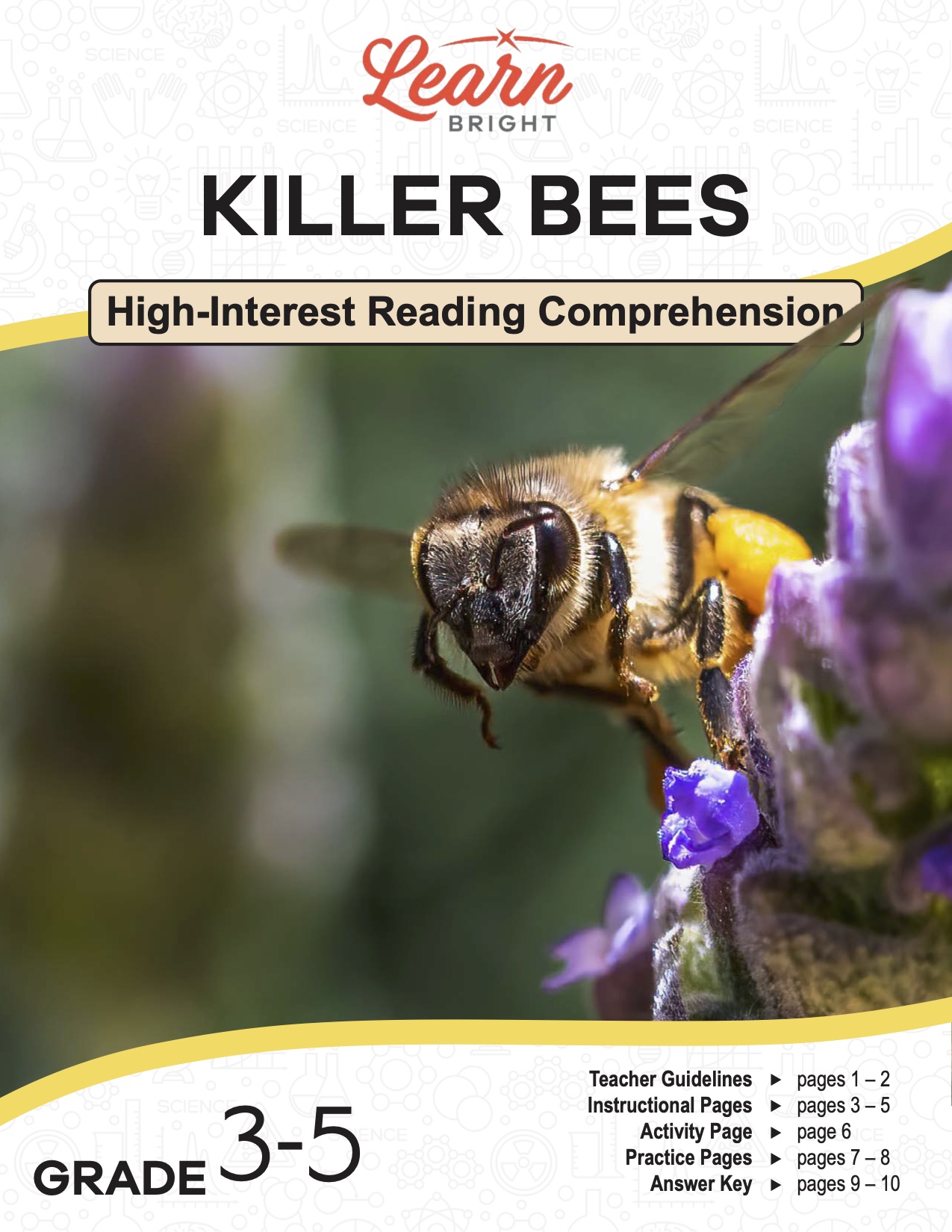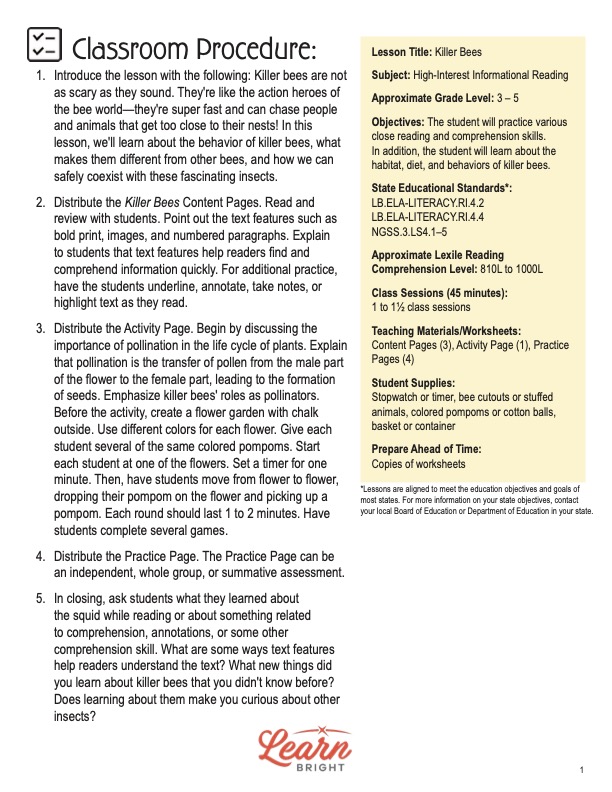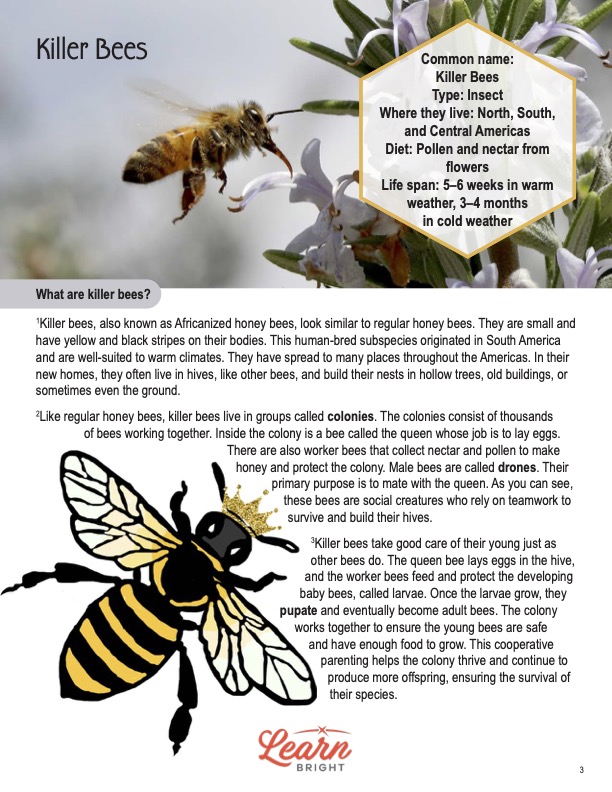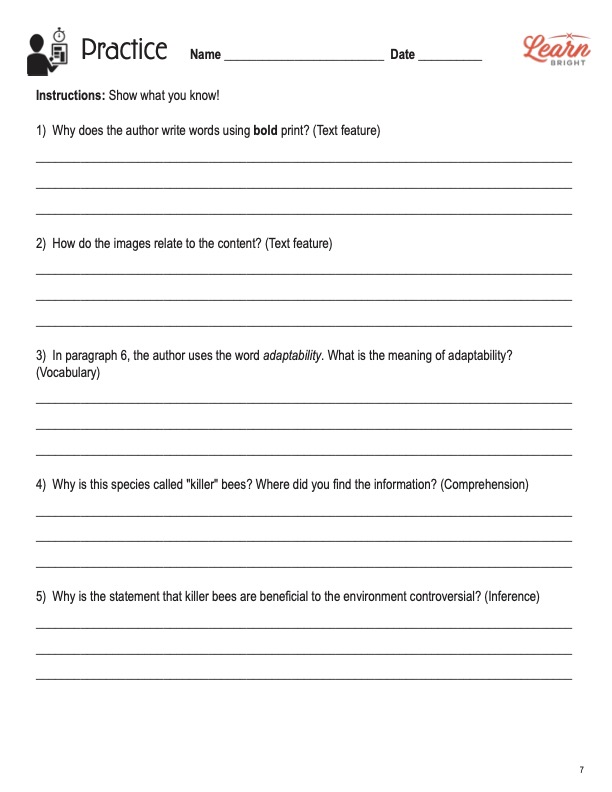Description
What our Killer Bees lesson plan includes
Lesson Objectives and Overview: Killer Bees is a high-interest reading comprehension lesson plan. As such, students will practice various close reading and comprehension skills. In addition, they will learn about the habitat, diet, and behaviors of killer bees. This lesson is for students in 3rd grade, 4th grade, and 5th grade.
Classroom Procedure
Every lesson plan provides you with a classroom procedure page that outlines a step-by-step guide to follow. You do not have to follow the guide exactly. The guide helps you organize the lesson and details when to hand out worksheets. It also lists information in the yellow box that you might find useful. You will find the lesson objectives, state standards, and number of class sessions the lesson should take to complete in this area. In addition, it describes the supplies you will need as well as what and how you need to prepare beforehand. Find the list of supplies you need for the activity in the “Student Supplies” section of the this page.
Teacher Notes
The teacher notes page provides an extra paragraph of information to help guide the lesson and remind you what to focus on. It explains that you can teach this lesson in a whole-class setting or as an independent, small-group activity. The blank lines on this page are available for you to write out thoughts and ideas you have as you prepare the lesson.
KILLER BEES LESSON PLAN CONTENT PAGES
What Are Killer Bees?
The Killer Bees lesson plan contains three content pages. It begins by providing a box of background information about this insect. Killer bees, also known as Africanized honey bees, look similar to regular honey bees. They are small and have yellow and black stripes on their bodies. This human-bred subspecies originated in South America and are well-suited to warm climates. They have spread to many places throughout the Americas. In their new homes, they often live in hives, like other bees, and build their nests in hollow trees, old buildings, or sometimes even the ground.
Like regular honey bees, killer bees live in groups called colonies. The colonies consist of thousands of bees working together. Inside the colony is a bee called the queen whose job is to lay eggs. There are also worker bees that collect nectar and pollen to make honey and protect the colony. Male bees are called drones. Their primary purpose is to mate with the queen. As you can see, these bees are social creatures who rely on teamwork to survive and build their hives.
Killer bees take good care of their young just as other bees do. The queen bee lays eggs in the hive, and the worker bees feed and protect the developing baby bees, called larvae. Once the larvae grow, they pupate and eventually become adult bees. The colony works together to ensure the young bees are safe and have enough food to grow. This cooperative parenting helps the colony thrive and continue to produce more offspring, ensuring the survival of their species.
What Do Killer Bees Eat?
Let’s talk food! Killer bees have a special diet that’s all about flowers. They eat two things: nectar and pollen. Nectar is a kind of sweet juice that the flowers make, and it gives the bees lots of energy. Pollen is like tiny pieces of dust that stick to bees as they visit the flower. It’s packed with nutrients, so it is a very healthy snack for them.
Killer bees are fantastic at gathering food. When they visit flowers to get nectar, they use a long, straw-like tongue called a proboscis. It’s like having a built-in straw for sipping. Some pollen sticks to their fuzzy bodies as they drink the nectar since they have little sticky hairs all over them. They don’t eat the pollen immediately; they collect it and return to their nest. Moving pollen from flower to flower is how they help plants make seeds and fruits while simultaneously getting their food.
Other Interesting Facts
Why are killer bees also called Africanized honey bees? It is because the ancestors from which they get their aggression are from Africa. (African honey bees are an especially hostile species.) Africanized honey bees, though, actually have a mix of both African and European bee genes. They are known for their adaptability to hot climates and their ability to thrive in different environments. Those traits make them attractive to scientists who want to study how animals adapt to new homes.
Scientists gave these insects the nickname “killer” bees because of their aggressive behavior when it comes to defending their nests. And because killer bees have killed some humans! They are famous for being fast fliers and quick to protect their nests. When threatened, they form a swarm and chase away the intruders. Scientists call this behavior aggressive defense. It’s like having a neighborhood watch that’s always on high alert! When they swarm, their buzzing can be quite loud, which is their way of warning others to stay away.
Considering their history, it’s no surprise that killer bees are also excellent explorers. They’ve traveled thousands of miles from South America to North America and continue spreading to new places. Scientists monitor their movements to understand how animals can adapt and expand their homes in different parts of the world. They’re on a never-ending adventure, discovering new lands and environments.
Why Are They Important?
There is a lot of controversy over the role killer bees play in the environment. Some scientists believe killer bees are vital to the environment because they are excellent pollinators. Pollen sticks to their fuzzy bodies when they visit flowers to collect nectar. As they move from one flower to another, they transfer this pollen, which helps plants make seeds and fruits.
This process is essential for the growth of many plants, including the ones we rely on for food, like fruits and vegetables. Plus, they produce great honey! Other scientists think that because killer bees are aggressive toward other bee species, they affect the ecological balance between species.
Killer bees are not endangered. They are quite successful and have spread to different parts of the Americas, even including Hawaii. However, their aggressive behavior when defending their nests can sometimes cause challenges for people and other animals. That’s why it’s essential to understand their behavior and take precautions when they are around. So, while killer bees are not endangered, we need to learn to coexist with them safely in the places where they live.
KILLER BEES LESSON PLAN WORKSHEETS
The Killer Bees lesson plan includes two worksheets: an activity worksheet and a practice worksheet. Each one will help students solidify their grasp of the material they learned throughout the lesson. You can refer to the classroom procedure guidelines to know when to hand out each worksheet.
POLLINATION ACTIVITY WORKSHEET
For the activity, students will take on the role of a killer bee as they pollinate flowers. There are instructions on the worksheet for you to prepare the activity and instructions for your students to complete it. Once students finish the rounds of pollinating flowers, they will answer the questions on the page.
KILLER BEES PRACTICE WORKSHEET
The practice worksheet requires students to answer a series of 11 questions. These questions all relate to the content pages, so students will need to refer to them often for the answers. In addition, each question provides which reading tool the question corresponds to, such as text feature, vocabulary, or comprehension.
Worksheet Answer Keys
At the end of the lesson plan document is an answer key for the practice worksheet. The correct answers are all in red to make it easier for you to compare them with students’ responses. If you choose to administer the lesson pages to your students via PDF, you will need to save a new file that omits these pages. Otherwise, you can simply print out the applicable pages and keep these as reference for yourself when grading assignments.










